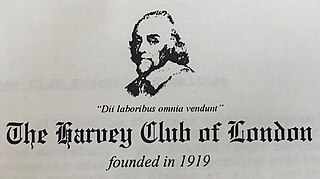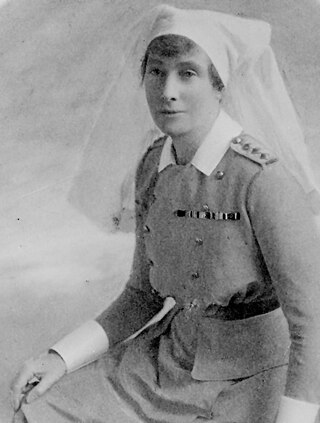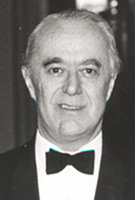
General surgery is a surgical specialty that focuses on alimentary canal and abdominal contents including the esophagus, stomach, small intestine, large intestine, liver, pancreas, gallbladder, appendix and bile ducts, and often the thyroid gland. General surgeons also deal with diseases involving the skin, breast, soft tissue, trauma, peripheral artery disease and hernias and perform endoscopic as such as gastroscopy, colonoscopy and laparoscopic procedures.

John William Michael Bliss (1941–2017) was a Canadian historian and author. Though his early works focused on business and political history, he also wrote biographies of physicians Frederick Banting, William Osler and Harvey Cushing. Bliss was a frequent commentator on political events and issues. He was an Officer of the Order of Canada.

The Royal College of Surgeons of England is an independent professional body and registered charity that promotes and advances standards of surgical care for patients, and regulates surgery and dentistry in England and Wales. The college is located at Lincoln's Inn Fields in London. It publishes multiple medical journals including the Annals of the Royal College of Surgeons of England, the Faculty Dental Journal, and the Bulletin of the Royal College of Surgeons of England.

Orthopedic surgery or orthopedics is the branch of surgery concerned with conditions involving the musculoskeletal system. Orthopedic surgeons use both surgical and nonsurgical means to treat musculoskeletal trauma, spine diseases, sports injuries, degenerative diseases, infections, tumors, and congenital disorders.
Charles George Drake was a Canadian neurosurgeon known for his work on treating aneurysms.
A medical specialty is a branch of medical practice that is focused on a defined group of patients, diseases, skills, or philosophy. Examples include those branches of medicine that deal exclusively with children (paediatrics), cancer (oncology), laboratory medicine (pathology), or primary care. After completing medical school or other basic training, physicians or surgeons and other clinicians usually further their medical education in a specific specialty of medicine by completing a multiple-year residency to become a specialist.
The Faculty of Dental Surgery of the Royal College of Surgeons of England is an independent UK professional body committed to enabling dental specialists to provide patients with the highest possible standards of practice and care. The faculty is an integral part of the Royal College of Surgeons of England and is located at the College's headquarters in Lincoln's Inn Fields in London.

John Webster Kirklin was an American cardiothoracic surgeon, general surgeon, prolific author and medical educator who is best remembered for refining John Gibbon's heart–lung bypass machine via a pump-oxygenator to make feasible under direct vision, routine open-heart surgery and repairs of some congenital heart defects. The success of these operations was combined with his other advances, including teamwork and developments in establishing the correct diagnosis before surgery and progress in computerized intensive care unit monitoring after open heart surgery.

In medicine, a surgeon is a medical doctor who performs surgery. Although there are different traditions in different times and places, a modern surgeon is also a licensed physician or received the same medical training as physicians before specializing in surgery.

Evarts Ambrose Graham was an American academic, physician, and surgeon.
Russell Claude Brock, Baron Brock was a leading British chest and heart surgeon and one of the pioneers of modern open-heart surgery. His achievements were recognised by a knighthood in 1954, a life peerage in 1965, and a host of other awards.

David Coston Sabiston, Jr., M.D.,, F.A.C.S. was an early innovator in cardiac surgery. In 1962, he performed a seminal procedure that paved the way for modern coronary-bypass surgery, grafting a vein from a patient's leg to bypass a blocked coronary artery during open-heart surgery. The patient died from unrelated complications, but Sabiston's technique and other surgeons' improvements on it led to the development of surgical coronary revascularization as it exists today.

Edward William Archibald was a Canadian surgeon. Archibald was born in Montreal, Quebec, and received his initial education in Grenoble, France. Upon returning to Canada, he attended McGill University, receiving his Doctor of Medicine there in 1896. Archibald became interested in the specialist field of surgery, and began an apprenticeship at Royal Victoria Hospital. After a year in Europe studying under two well known physicians, the young surgeon was appointed to the staff of the Royal Victoria Hospital's Department of Surgical Pathology. However, Archibald became ill with tuberculosis, and moved to New York City for treatment. Upon his recovery, the surgeon returned to Royal Victoria Hospital. There, he developed what he had learned in Europe, and came to be dubbed Canada's first neurosurgeon.

Charles Frederick William Illingworth was a British surgeon who specialised in gastroenterology. Along with a range of teaching and research interests, he wrote several surgical textbooks, and played a leading role in university and medical administration.
Kathryn Dorothy Duncan Anderson is a British-American pediatric surgeon. She was the first woman to hold office in the American College of Surgeons and the first woman president of the American Pediatric Surgical Association. She was a Nina Starr Braunwald Award laureate.
Bernard Langer was a Canadian surgeon and educator. In 2015, he was inducted into the Canadian Medical Hall of Fame.
Jessie Catherine Gray was a Canadian cancer surgeon, educator, and researcher. Known as the Canadian "First Lady of Surgery", Gray is described as a trailblazer for women surgeons and an example that women could excel in the male-dominated field of general surgery. During her career, she was considered one of the top four cancer surgeons in North America, and she earned many firsts and fellowships in her field.

The Harvey Club of London is the oldest currently active medical club in Canada. It was founded by Drs. James W. Crane and C.M. Crawford in 1919 in London, Ontario. The club was initially founded as a way for practicing physicians to stay abreast of new developments in biomedical sciences, analogous to the modern concept of continuing medical education, a function that it continues to perform with annual presentations of papers. The club also provides academic and financial support to students at the medical school of Western University.

Edith Campbell, was a Canadian nurse. She served with the Canadian Army Medical Corps in the First World War and was one of the first Canadian nurses to arrive in England to assist in the establishment of the Duchess of Connaught Canadian Red Cross Hospital, a field hospital in Taplow, Buckinghamshire, and serve during the First World War. She later served on the Western Front, being awarded the Royal Red Cross, first class, and the Military Medal. She was also twice mentioned in despatches.

James Johnston Mason Brown OBE, FRCSEd was a Scottish paediatric surgeon. During World War II he served as a surgical specialist with the 8th Army in North Africa and Italy and was awarded the OBE for this service. As surgeon-in-chief at the Royal Hospital for Sick Children in Edinburgh, he edited the major textbook The Surgery of Childhood. He was the joint founder of the Scottish Surgical Paediatric Society and a founder member of the British Association of Paediatric Surgeons (BAPS), of which he became president. He was elected President of the Royal College of Surgeons of Edinburgh (RCSEd) in 1962 but died in office aged 56 years.












